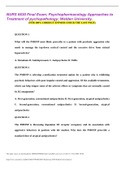Summary
Summary MSc UvA Business Administration - Consumer Behaviour (6314M0159Y) [LECTURES & KNOWLEDGE CLIPS]
- Course
- Institution
Notes of all the compulsory lectures and knowledge clips of the course Consumer Behaviour/Consumer Behavior, (6314M0159Y). This is a mandatory course for both tracks, Digital Marketing and Consumer Marketing. Both are specialisation tracks of the MSc Business Administration at University of Amsterd...
[Show more]












